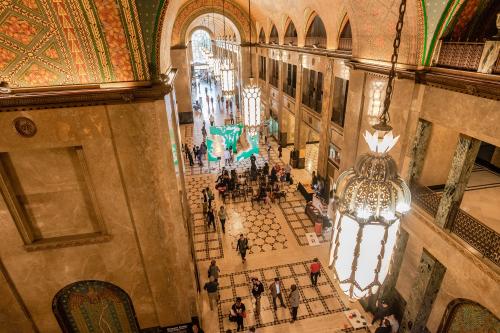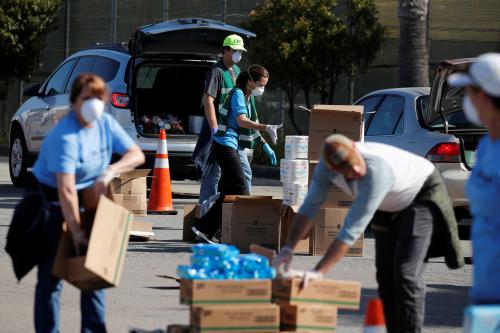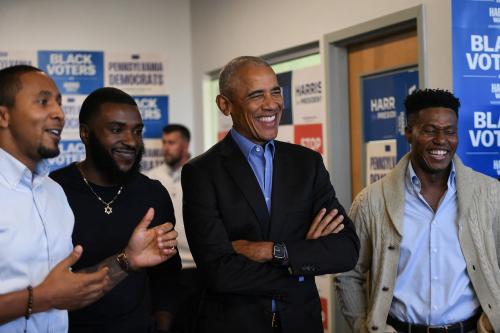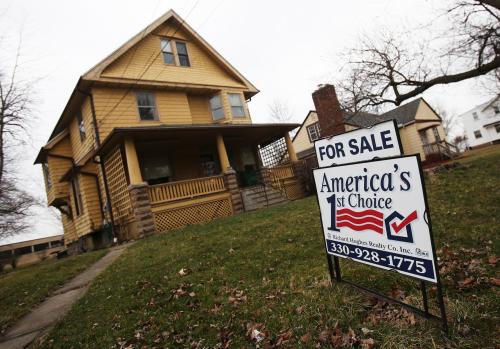Placemaking Postcards is a blog series from the Bass Center for Transformative Placemaking at Brookings where policymakers and practitioners guest-author promising placemaking efforts from across the U.S. and abroad that foster connected, vibrant, and inclusive communities. In line with the principle tenets of placemaking, the goal of the series is to recognize the community as the expert, highlight voices from the field, and to create a community of learning and practice around transformative placemaking.
 COVID-19’s disparate impact on Black communities, the ongoing violence police inflict on Black Americans, and the ensuing protests gripping our nation have brought new attention to many intersecting, long-standing social injustices. Among them is the legacy of decades of discrimination and disinvestment that have systematically denied Black neighborhoods the community resources they need to thrive, including jobs, health care, affordable housing, green space, and small business capital.
COVID-19’s disparate impact on Black communities, the ongoing violence police inflict on Black Americans, and the ensuing protests gripping our nation have brought new attention to many intersecting, long-standing social injustices. Among them is the legacy of decades of discrimination and disinvestment that have systematically denied Black neighborhoods the community resources they need to thrive, including jobs, health care, affordable housing, green space, and small business capital.
In the Wilmington, Del. neighborhood of West Center City, this legacy is evident in the vacant storefronts, the poor street conditions, and the deteriorating public infrastructure. Local small businesses have stepped in to provide essential goods, services, and camaraderie where larger chains often would not. But when the steel grates roll down those businesses’ doors and windows at night, the neighborhood’s legacy of disinvestment is apparent.
There is a long history of both disinvestment and resistance in Wilmington that still feels very present today. In 1968, civil unrest in response to Martin Luther King, Jr.’s assassination prompted an unprecedented nine-month military occupation of Wilmington. This only deepened the Black community’s collective distrust in government, after decades of exclusion from jobs, commerce, fair and affordable housing, and safe neighborhoods.
Investment in public spaces alone can do little to combat economic exclusion and discrimination carried out over generations. But with an understanding of the social, economic, and health benefits that public spaces can bring to communities, the Wilmington Alliance embarked on an inclusive public space revitalization process in West Center City.
Revitalizing neglected public spaces to rebuild trust
In 2015, the Wilmington Alliance launched Vacant to Vibrant, a multiyear endeavor to engage neighborhood residents in a revitalization plan for two vacant lots that had sat unused and inaccessible for decades. One was filled with rocks and refuse, and the other contained soil permeated with poisonous chemicals. Both were raw reminders of the public sector’s blatant disregard for residents’ needs. We hoped the inclusive engagement process would plant the seeds for restoring trust from this neglect in West Center City, and help build capacity for residents to advocate for the public services and amenities they have long been denied.
It has been a difficult road. In the early stages of planning and design, residents expressed skepticism of the Alliance’s intentions, presuming that these new spaces would be revitalized for the benefit of people outside the community. To be responsive to residents’ rightful wariness, we held 10 engagement sessions and conducted outreach at regular community destinations, bodegas, hair salons, and street corners to understand residents’ desires for the spaces and reiterate that they would belong to everyone.
In 2017, after much community feedback, we renamed one of the lots “Rock Lot”—a nod to its former contents—and added picnic bench seating, fresh grass and trees, and a public lending library to encourage all-ages engagement. We also added programming such as spoken word, poetry, and hand drumming performances to encourage liveliness and inclusive interaction.
The second space, at 7th & West Streets, required a more aggressive approach to remediate the very real dangers of soil contamination. Over the course of a year, we removed the soil, concrete, and metal from the property and planted trees and an 11-bed vegetable garden. We hired a local farmer-in-residence to oversee the vegetable garden, provide a warm welcome to residents, answer questions about proper planting practices, and assign garden space for families to plant seeds. Since its November 2019 opening, the garden has seen growing use, and during the COVID-19 pandemic—in which food access has increasingly become a concern for many—we’ve used the garden to harvest food and share it with neighbors in the community.
Inclusive engagement is the first step
Vacant to Vibrant is an ongoing process and requires constant reflection, particularly in light of rapidly shifting public health and political contexts. Even though we’ve seen great progress with community attendance in the parks and increased use of the vegetable garden—indicating that new seeds of community trust are indeed emerging—we’re still at the very beginning of the process. To help get to the place where residents feel full ownership over the spaces (and feel supported in advocating for the broader amenities and services they want in their neighborhood), the Wilmington Alliance is embracing the following practices:
Continuously adapting to community needs: Amid COVID-19, West Center City’s revitalized lots have provided critical outdoor spaces for those who had few other options and have been a vital source of food access during a time of heightened food insecurity. But these will not always be the community’s desires for the space. As public health, economic, and political contexts change, we must provide adaptable spaces responsive to residents’ needs. To get us there, our staff and farmer-in-residence are constantly spending time in the space, listening and responding to feedback. As COVID-19 restrictions lift, they plan to expand these efforts with additional outreach at community gathering places.
Moving from engagement to ownership: Rather than inviting residents to give input on public spaces, we are working in the long term to pivot our model to one that provides residents with the training and capacity they need to create and reimagine their own civic spaces. This will involve adding capacity-building training to engagement sessions, presenting on best-practice models, and facilitating community-led mapping exercises so residents can expand their demands for public spaces and own the process for creating them.
Shifting the balance of power: Building capacity must go beyond reimagining new public spaces—we must support long-term, community-led organizing that is responsive to multiple neighborhood concerns. We’ve been working regularly to support a newly formed neighborhood group that advocates for the changes they’d like to see, and are currently assisting organizing amid COVID-19 by providing access to space and technology for virtual meetings. Our long-term goal is to help build the capacity for resident groups and associations to lead the process.
After months of sheltering in place, the Wilmington Alliance is hopeful that we can emerge from this moment with a collective urgency and renewed commitment to working with communities to invest in places that have long been neglected. Rebuilding trust takes time and public spaces are just one small part of the process, but we hope that the engagement and capacity that start here bring us closer to holistic change in the months ahead.
Photo credit: Wilmington Alliance







Commentary
How Wilmington, Del. is revitalizing vacant land to rebuild community trust
June 23, 2020